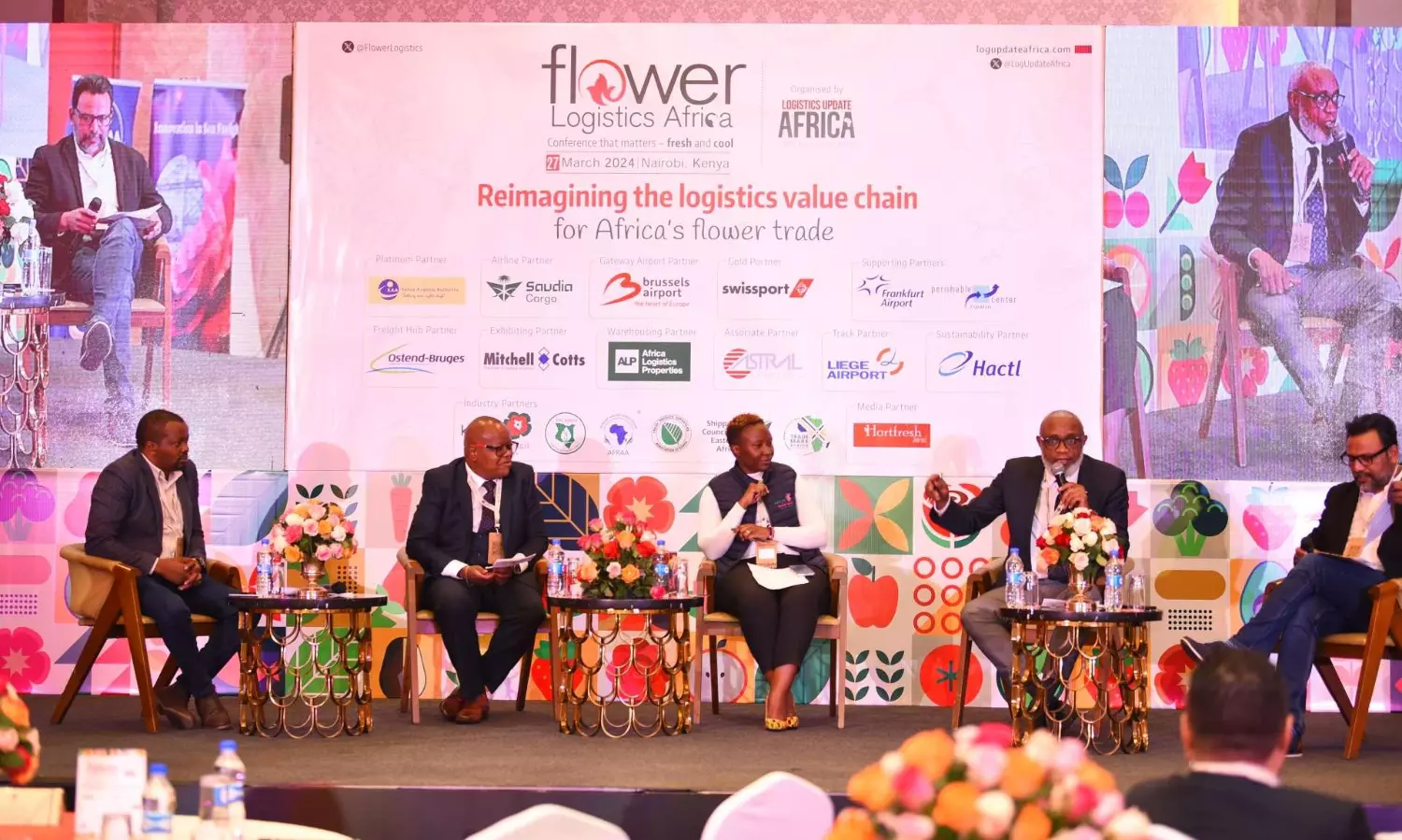Building strong supply chain for competitive Kenyan perishable trade

Nick Mwaura of International Procurement & Logistics (IPL), Ken Mbogo of Saudia Cargo, Lina Jamwa of Kenya Flower Council, Jacob Bwana of Kenya Airports Authority and Reji John of Logistics Update Africa during the first business session of Flower Logistics Africa 2024.
Kenyan flower and perishable trade is at a crossroads. While it dominates the foreign markets and is preparing to fly high, global competition is rising, logistics infrastructure is inadequate, freight rates are rising, and geopolitical implications are not helping. However, there are opportunities for a sustainable, digitalised future.
"Kenya's floriculture contributes 1 percent of the national GDP, however, with global competition intensifying, especially from Latin America, Kenya's floriculture faces multifaceted challenges.”
These are the words of Lina Jamwa, membership, advocacy and communications manager, Kenya Flower Council, who emphasised the flower industry's significant role and raised concerns about its logistics challenges.
She was speaking at the two-day conference Flower Logistics Africa (FLA) and Perishable Logistics Africa (PLA) 2024 organised by Logistics Update Africa in Nairobi, Kenya on 27 and 28 March 2024.
The sixth edition of FLA and fifth edition of PLA were supported by Kenya Airports Authority (KAA), Saudia Cargo, Brussels Airport, Swissport, Frankfurt Airport, Perishable Center Frankfurt, Ostend–Bruges International Airport, Mitchell Cotts, Africa Logistics Properties, Astral Aviation, Liege Airport and Hong Kong Air Cargo Terminals (Hactl), along with industry partners Kenya Flower Council (KFC), Fresh Produce Consortium of Kenya (FPCK), African Airlines Association (AFRAA), Fresh Produce Exporters Association of Kenya (FPEAK), Shippers Council of East Africa, TradeMark Africa and Avacado Exporters Association of Kenya.
Jamwa highlighted the Red Sea crisis as a pressing logistical challenge, increasing transit times and freight costs. The situation forced Kenyan exporters to seek alternative routes like the Cape of Good Hope, significantly impacting logistical expenses and supply chain dynamics. "Because of the Red Sea crisis, we are now using the Cape of Good Hope, making our logistical expenses high," noted Jamwa.
As the representative of the shippers, she also pointed out the cost of air freight as one of the key things that the shippers like to take to the service providers. “If there is a way that this can be brought down, then this will actually make a very big difference in the industry. We understand that there are factors for this but good incentives from the government could actually bring down freight costs,” she added.
Beyond the cost of freight and the Red Sea issues, one of the most important topic of discussion throughout the conference was the logistics infrastructure that supports the flower trade from Kenya.
For instance, Praveen Singh, technical commercial manager, Black Tulip Group, pointed out that the floriculture industry is growing at a steady pace but the logistics infrastructure is not built to handle the volumes. He particularly noted how much this infrastructure has to increase its handling capacity during the peaks of Valentine's Day or Mother's Day.
“The Kenyan floriculture industry is growing at a very good pace with a 7 to 8 percent rate every year. It was above 10 percent after the Covid-19 pandemic, in 2021 and 2022. On the other side, the infrastructure at the farm level and the airport does not match the pace,” he said.
“During Valentine's Day or Women's Day, volumes go up three, four, five times. This year, it was five to six times because in December, production was very down due to bad weather. So a lot of production came to Valentine’s Day and the volumes were very huge. And there was an imbalance between handling the logistics at the airport to the final destination. So there is room for improvement in terms of infrastructure,” he added.
Many more stakeholders expressed this concern about African and Kenyan logistics infrastructure to handle the present and future volumes of perishables produced in the country.
Patrice Ngenga, Technical Standards and Compliance Officer, Fresh Produce Exporters Association of Kenya (FPEAK), noted that Kenya is better than its neighbours but there is a long way to go. He pointed out that Kenyan fresh produce has only two exit points: Jomo Kenyatta International Airport (JKIA) and the Port of Mombasa.
“Those are the two exit points that have the capacity to handle fresh produce. If you're growing fresh produce in the rift region or western region, you have to either come to Nairobi or if you're dealing with fruits, which go by sea, you have to drive all the way to Mombasa. That's a long time that you spend on the road,” he said.
He also noted there are other potential exit points in the country that dont have the capacity and infrastructure to handle the requirements posted by horticultural businesses.
“Facilities like the Eldoret International Airport, Kisumu International Airport don't have the necessary facilities. Even Mombasa is going to be overwhelmed in the next few years. Because by 2030, we want to have 50% of the fresh produce grown in Kenya exported by sea. So if half of all the flowers and half of all the vegetables go down to Mombasa, it's going to be a challenge.
Meanwhile, Kenya is also improving its airport infrastructure to handle the incoming cargo growth. Jacob Bwana, GM Marketing and Business Development, Kenya Airports Authority, gave an update about the infrastructural developments and strategies at Kenyan airports.
“Decongesting JKIA is a priority. JKIA is poised to increase the cargo freight area so that we will be able to handle more widebody aircraft.”
He informed that Moi International Airport at Mombasa is getting expanded to embrace the sea-air strategy. “So that we can increase not only our perishables but also the transit cargo and decongest the Port of Mombasa.”
He also spoke about how the Lamu Port can feed into the Isiolo International Airport with the Aea-Air Cargo and compared it with how Ethiopia uses Djibouti. “Djibouti is a port country but Ethiopia is already using Djibouti for Sea-Air which is a longer distance that we have between Lamu and Isiolo.
Speaking about Kisumu International Airport, Bwana said, “The Airport is coming up so that we can capitalise on the multimodal distribution in the landlocked hinterland of eastern central Africa.
“African Continental Free Trade Area (AfCFTA) is going to come and our infra-Africa trade is going to improve our GDP further than even trading across the seas because of speed as the value proposition,” he added.
Jamwa of KFC also spoke about how the Port of Mombasa is spearheading innovative measures. Their plan includes shifting 50% of freight from air to sea by 2030, aiming to reduce CO2 emissions and enhance efficiency through automation and technology integration. This move aligns with the EU-funded Business Environment and Export Enhancement Program (BEEP), focusing on sustainability across crucial export sectors like flowers, mangos, and avocados.
The conference also highlighted digitalisation as a game-changer in flower logistics. Jeroen van der Hulst, Owner and Founder of FlowerWatch, underscored how innovative technologies are transforming the sector, providing transparency, reducing waste, and enhancing sustainability. Moses Ndegwa, Supply Chain Coordinator at AAA Growers, shared practical insights into how digital solutions streamline operations and improve efficiency.
Sam Quintelier, Senior Business & Network Development Manager Cargo at Brussels Airport, emphasised the power of data analytics in ensuring supply chain visibility and risk mitigation. "Leveraging data analytics can optimise cargo operations, ensuring smooth global flower shipments," Quintelier remarked during the panel discussion.
Bwana of KAA echoed the importance of sustainability and community-building within the industry. "Sustainability involves the three Ps—the people, the planet, and profit. We are looking to create communities where our stakeholders compete within themselves on a positive note," emphasised Bwana.
Ken Mbogo, Regional Director of Africa at Saudia Cargo, highlighted upcoming trends such as sustainable aviation fuel and aircraft modernisation. "Air freight is important but will not replace sea freight. Air freight will complement sea freights," noted Mbogo, emphasising the industry's agility and adaptability. During the event, Sanjeev Gadhia, CEO at Astral Aviation, also talked about the airline's five-year sustainability plans that involve the modernisation of the fleet along with opening new route operations, like Sharjah to Eldoret, to improve the connectivity of air cargos.
The FLA 2024 conference catalysed dialogue, collaboration, and action towards a more robust and sustainable floriculture industry in Africa. With a strategic focus on digitalisation, data analytics, and sustainability initiatives, Kenya's floriculture sector is poised for transformative growth, ensuring it remains a global leader in flower exports while reducing its environmental footprint.
As the industry navigates geopolitical disruptions and logistical complexities, strategic partnerships, technological advancements, and a commitment to sustainable practices will be vital in unlocking new avenues for growth and resilience.
In conclusion, the intersection of digitalisation and sustainability marks a new chapter for Kenya's floriculture industry, promising a future where efficiency, profitability, and environmental stewardship are integrated.
This feature was originally published in the May-June 2024 issue of Logistics Update Africa



